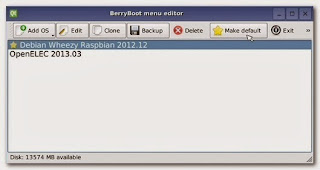what is raspberry pi?
the raspberry pi is fantastic little computer that is capable of doing all sorts of tings,unfortunately it supports only one operating system at a time,in this tutorial we can boot as many Raspberry Pi operating systems as you want
What is Berry Boot?
BerryBoot is a boot management tool for the raspberry pi that makes your experience more crispy in functionality. The benefit of it is that it allows you to boot up as many as Raspberry Pi operating systems off the SD card. the Berry boot configuration toll allows you to download additional Raspberry Pi optimized distributions, current disributions are berrywebserver(Webserver Bundle: Lighttpd+PHP+SQLITE)
Berryterminal(LTSP/Edubuntu thinclient), puppy linux and so on.....
In addition to the distributions included, you can also add your own Linux distributions.
Getting started;configuration....
- after downloading the installer and extracting the contents of it to your SD card, it’s time to start the config. Insert the SD card in your Raspberry Pi unit and plug in the power cable to boot it up. You will see boot process and then you’ll arrive at the GUI of the configuration wizard
- configure the video output (select overscan based on whether you see or not the green calibration bars at the top and bottom ). Set your connection to Wi-Fi. then set your timezone and keyboard preferences.
- After configuring the network connection, you will be asked to select a disk
- The default is the SD card. If you want to install the distributions to an attached flash or USB HDD, attach it now. Once you see the disk you wish to use ,select it and press the Format button.
- After a minute, you’ll be directed into the Add OS menu where you can select the first (of many) operating systems you want to install to your BerryBoot card. After selecting it, press OK to start the installation process.
- Once the image has finished downloading and installing, the BerryBoot menu editor will appear,
- in the menu editor, you can perform a variety of functions. You can add another operating system or remove existing ones and set the default operating system. You can edit the properties of the individual images to change the name and the memory location. You can replicate the operating system. You can backup the entire SD card or individual operating system installs to an external storage device.
- All those features are really awesome, what we’re most interested in now is adding an additional operating system. Click Add OS. This will return you to the Add OS menu we were in just a moment ago—we’re going to add OpenELEC to our BerryBoot system now. Make your selection and hit OK.When the installation of the second operating system image is complete, you can then select the one you wish to be the default and click the Make default button. We’re opting to make Raspbian our default operating system:

- Now, we’re ready to exit the editor and try the multiboot process. click on the Exit button on the menu bar. A moment later you will be directed back to the main BerryBoot menu poof ! done now install multiple boots and use
Note:If you set a default operating system, it will be automatically counting down to boot it. If you didn’t, it will be idle, for you to select which operating system you want to boot into. The default timeout for the boot menu selection is 10 seconds.









0 comments
Post a Comment